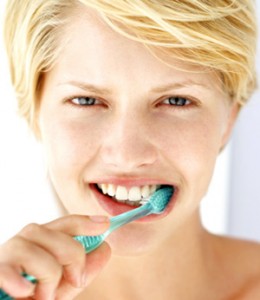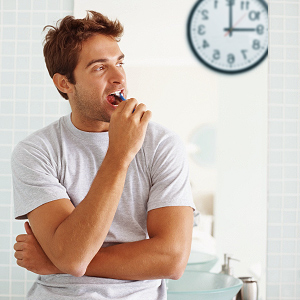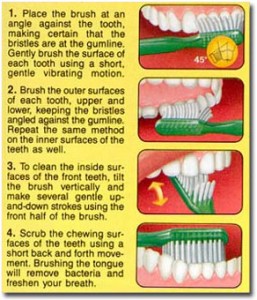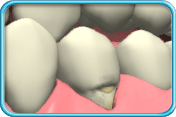Various methods of tooth brushing have been recommended and classified to the type of motion performed by the brush. In reality it does not matter exactly how a toothbrush is used, as long as plaque is effectively removed without trauma to the gums. Where plaque still persists, the dental professional should teach effective oral hygiene. The recommended toothbrushing method will depend upon the dexterity of the individual as well as the position of the teeth. The vibratory Bass technique is the most useful and will be described in detail.
Why brush your teeth?
The objectives of toothbrushing are to
- remove plaque and disturb reformation on tooth surfaces
- clean teeth of food, debris, and stain
- stimulate the gum tissues
- apply dentifrice with specific ingredients to address cavities, gum disease or sensitivity
Toothbrushing Time and Frequency
Thorough toothbrushing requires a different amount of time for each individual; it depends on such factors as the inborn tendency to accumulate plaque and debris; the psychomotor skills; and the adequacy of clearance of foods, bacteria, and debris by the saliva. Only after individuals have repeatedly brushed their teeth under the supervision of a dental professional can the adequacy of cleaning in a given time be determined. It is commonly recommended to brush for 2 to 3 minutes with around 30 seconds for each quadrant in the mouth. Often a compromise is made by suggesting 5 to 10 strokes in each area or by advocating the use of a timer. This amount of time, which might be adequate for the average person, may not be sufficient for individuals that are in need of maximum plaque-control programs.
It is often advised to brush thoroughly twice a day using a soft bristled toothbrush. Every time the teeth are cleaned, plaque that is constantly forming on your teeth is removed. If plaque is allowed to build up it can harden into tartar (also called calculus), which can then only be removed by dental professional. Toothbrushing is best done as the last thing at night, so that the remains of the paste remain in the mouth when asleep because salivary flow is reduced. Brush on one other occasion for example, on rising, before breakfast.
Toothbrushing Procedures
Occlusal (Biting) Surfaces
The occlusal or biting surfaces may be cleaned by either short vibratory strokes, with pressure being maintained to accomplish as deep a penetration of the pits and fissures as possible; or a rapid back-and-forth vibrating motion to force the bristles into the pits and fissures (the grooves on teeth), followed by a sweeping motion to expel the dislodged debris.
Long, sweeping, horizontal strokes are contraindicated, because the toothbrush bristles have minimum contact in the deeper and more critical fissures. The grooves of the pits and fissures are too narrow for bristle penetration and, whatever the technique, are inaccessible for adequate cleaning. This helps explain why more than 60% of all cavities in the mouth are found on the occlusal surface, even though most individuals attempt to brush this surface.
Toothbrushing for children
When teeth are erupting they are below the normal occlusal plane and must be cleaned individually by bringing toothbrush in at right angles to the teeth. With erupting of the first permanent back teeth (molars) the child (aged about 6 years) needs help to get these surfaces clean. The helper should stand behind the child to ‘finish off’ their brushing.
The Bass method
The toothbrush is held so that the bristles are directed downwards towards the tooth and then placed against the gums margin at an angle of 45 degrees to the long axis of tooth. The brush is pressed so that the bristles are flexed and the tips forced between the teeth. It is then vibrated either in back-and-forth direction or by a rotary movement of the handle, keeping the tips of the bristles in position. The Bass technique is effective in removing plaque adjacent to and directly below the gums margin. Since the bristles of the brush are directed towards the gum tissues and may be potentially damaging, a hard toothbrush must not be used with this method.
Interdental areas
The surfaces between two adjacent teeth and areas where teeth are not positioned correctly cannot be reached with an ordinary toothbrush. Consequently, additional aids such as dental floss or tape, single-tufted brushes or interdental brushes may be required for these areas. Choice will depend on the shape of the interdental area and the dexterity of the individual.
Tooth enamel wear from toothbrushing
Toothbrush abrasion, or the wearing away of tooth substances, occurs from the use of highly abrasive dentifrices, too-firm brush bristles, incorrect brushing methods, and excessive pressure during brushing. Common abrasion locations are on the neck surfaces of the teeth or exposed root surfaces. Because enamel is harder than cementum (tissues on the tooth root), tooth damage usually occurs as a V-shaped, horizontal notch immediately at the junction of enamel and cementum. Further progress of the abrasion can be minimized by use of soft-bristle brushes, changes in the angle of how you brush, pulsing instead of stroking when you brush, the use of less abrasive dentifrices, and less pressure during brushing.



